Aimin Zhou
OmniEduBench: A Comprehensive Chinese Benchmark for Evaluating Large Language Models in Education
Oct 30, 2025Abstract:With the rapid development of large language models (LLMs), various LLM-based works have been widely applied in educational fields. However, most existing LLMs and their benchmarks focus primarily on the knowledge dimension, largely neglecting the evaluation of cultivation capabilities that are essential for real-world educational scenarios. Additionally, current benchmarks are often limited to a single subject or question type, lacking sufficient diversity. This issue is particularly prominent within the Chinese context. To address this gap, we introduce OmniEduBench, a comprehensive Chinese educational benchmark. OmniEduBench consists of 24.602K high-quality question-answer pairs. The data is meticulously divided into two core dimensions: the knowledge dimension and the cultivation dimension, which contain 18.121K and 6.481K entries, respectively. Each dimension is further subdivided into 6 fine-grained categories, covering a total of 61 different subjects (41 in the knowledge and 20 in the cultivation). Furthermore, the dataset features a rich variety of question formats, including 11 common exam question types, providing a solid foundation for comprehensively evaluating LLMs' capabilities in education. Extensive experiments on 11 mainstream open-source and closed-source LLMs reveal a clear performance gap. In the knowledge dimension, only Gemini-2.5 Pro surpassed 60\% accuracy, while in the cultivation dimension, the best-performing model, QWQ, still trailed human intelligence by nearly 30\%. These results highlight the substantial room for improvement and underscore the challenges of applying LLMs in education.
SID: Benchmarking Guided Instruction Capabilities in STEM Education with a Socratic Interdisciplinary Dialogues Dataset
Aug 06, 2025Abstract:Fostering students' abilities for knowledge integration and transfer in complex problem-solving scenarios is a core objective of modern education, and interdisciplinary STEM is a key pathway to achieve this, yet it requires expert guidance that is difficult to scale. While LLMs offer potential in this regard, their true capability for guided instruction remains unclear due to the lack of an effective evaluation benchmark. To address this, we introduce SID, the first benchmark designed to systematically evaluate the higher-order guidance capabilities of LLMs in multi-turn, interdisciplinary Socratic dialogues. Our contributions include a large-scale dataset of 10,000 dialogue turns across 48 complex STEM projects, a novel annotation schema for capturing deep pedagogical features, and a new suite of evaluation metrics (e.g., X-SRG). Baseline experiments confirm that even state-of-the-art LLMs struggle to execute effective guided dialogues that lead students to achieve knowledge integration and transfer. This highlights the critical value of our benchmark in driving the development of more pedagogically-aware LLMs.
Cultivating Helpful, Personalized, and Creative AI Tutors: A Framework for Pedagogical Alignment using Reinforcement Learning
Jul 27, 2025Abstract:The integration of large language models (LLMs) into education presents unprecedented opportunities for scalable personalized learning. However, standard LLMs often function as generic information providers, lacking alignment with fundamental pedagogical principles such as helpfulness, student-centered personalization, and creativity cultivation. To bridge this gap, we propose EduAlign, a novel framework designed to guide LLMs toward becoming more effective and responsible educational assistants. EduAlign consists of two main stages. In the first stage, we curate a dataset of 8k educational interactions and annotate them-both manually and automatically-along three key educational dimensions: Helpfulness, Personalization, and Creativity (HPC). These annotations are used to train HPC-RM, a multi-dimensional reward model capable of accurately scoring LLM outputs according to these educational principles. We further evaluate the consistency and reliability of this reward model. In the second stage, we leverage HPC-RM as a reward signal to fine-tune a pre-trained LLM using Group Relative Policy Optimization (GRPO) on a set of 2k diverse prompts. We then assess the pre- and post-finetuning models on both educational and general-domain benchmarks across the three HPC dimensions. Experimental results demonstrate that the fine-tuned model exhibits significantly improved alignment with pedagogical helpfulness, personalization, and creativity stimulation. This study presents a scalable and effective approach to aligning LLMs with nuanced and desirable educational traits, paving the way for the development of more engaging, pedagogically aligned AI tutors.
The Role of Visual Modality in Multimodal Mathematical Reasoning: Challenges and Insights
Mar 06, 2025Abstract:Recent research has increasingly focused on multimodal mathematical reasoning, particularly emphasizing the creation of relevant datasets and benchmarks. Despite this, the role of visual information in reasoning has been underexplored. Our findings show that existing multimodal mathematical models minimally leverage visual information, and model performance remains largely unaffected by changes to or removal of images in the dataset. We attribute this to the dominance of textual information and answer options that inadvertently guide the model to correct answers. To improve evaluation methods, we introduce the HC-M3D dataset, specifically designed to require image reliance for problem-solving and to challenge models with similar, yet distinct, images that change the correct answer. In testing leading models, their failure to detect these subtle visual differences suggests limitations in current visual perception capabilities. Additionally, we observe that the common approach of improving general VQA capabilities by combining various types of image encoders does not contribute to math reasoning performance. This finding also presents a challenge to enhancing visual reliance during math reasoning. Our benchmark and code would be available at \href{https://github.com/Yufang-Liu/visual_modality_role}{https://github.com/Yufang-Liu/visual\_modality\_role}.
Echo: A Large Language Model with Temporal Episodic Memory
Feb 22, 2025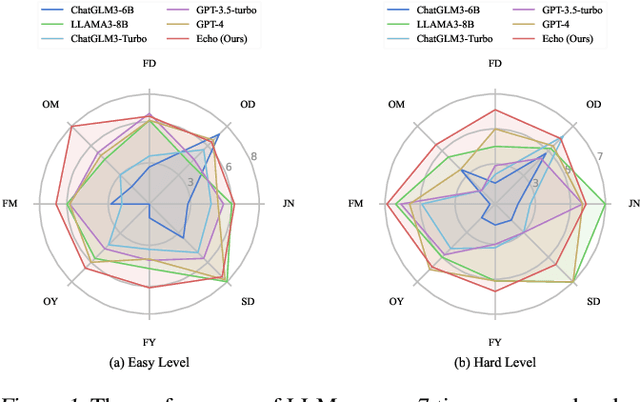
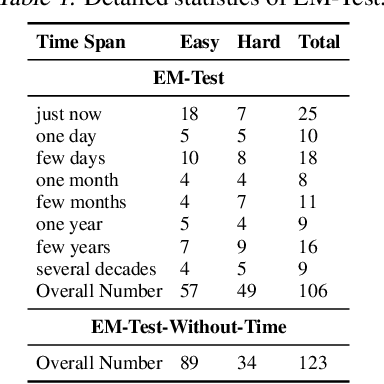
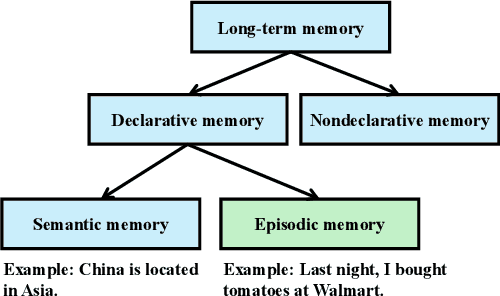
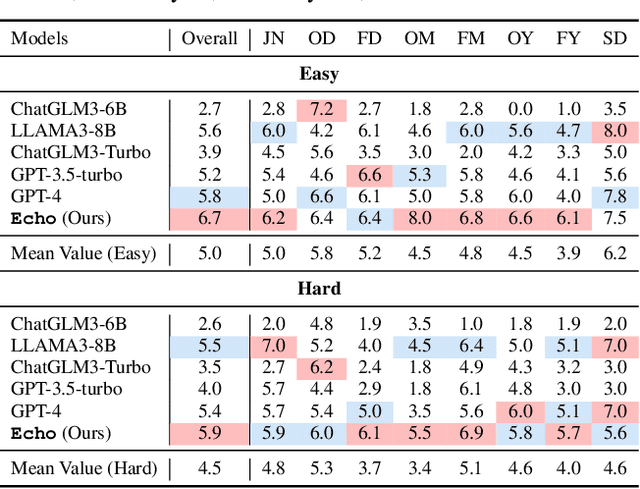
Abstract:Research on large language models (LLMs) has shown remarkable performance in domains such as mathematics, programming, and literary creation. However, most studies have focused on semantic memory-based question answering, neglecting LLMs' potential to handle episodic memory (EM)-related queries. This oversight has led to suboptimal performance in applications requiring EM, including emotional companionship, personal AI assistants, and AI teachers. To address this gap, we introduce Echo, a LLM enhanced with temporal episodic memory. We propose a Multi-Agent Data Generation Framework that guides the model in generating multi-turn, complex scenario episodic memory dialogue data (EM-Train). Temporal information is innovatively incorporated into the LLM training process, and Echo is trained using the EM-Train. Furthermore, We develop an EM-Test benchmark specifically designed to evaluate LLMs' episodic memory capabilities. The EM-Test assesses performance across various time spans and difficulty levels, providing a comprehensive evaluation of multi-turn episodic memory dialogues. Our experiments demonstrate that Echo significantly outperforms state-of-the-art LLMs on EM-Test. Additionally, a qualitative analysis reveals Echo's potential to exhibit human-like episodic memory capabilities. We will open-source all datasets, code, and model weights.
LLM-KT: Aligning Large Language Models with Knowledge Tracing using a Plug-and-Play Instruction
Feb 05, 2025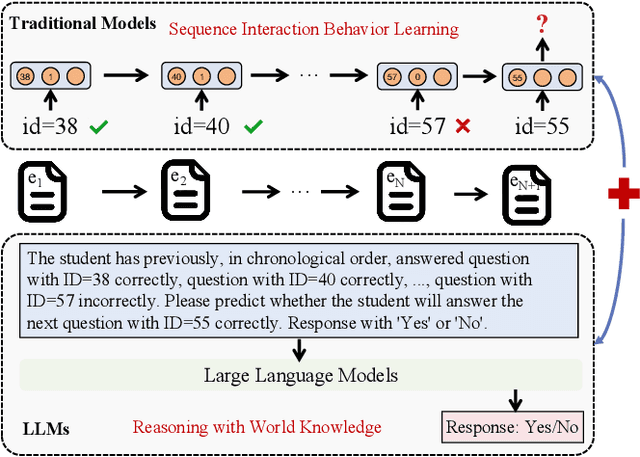

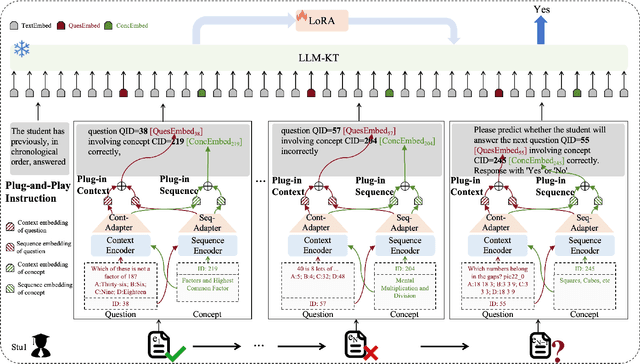
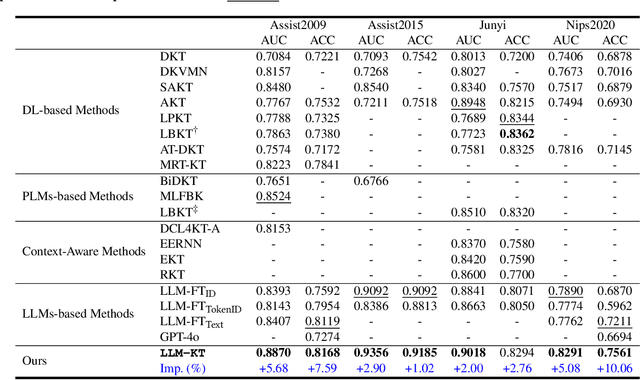
Abstract:The knowledge tracing (KT) problem is an extremely important topic in personalized education, which aims to predict whether students can correctly answer the next question based on their past question-answer records. Prior work on this task mainly focused on learning the sequence of behaviors based on the IDs or textual information. However, these studies usually fail to capture students' sufficient behavioral patterns without reasoning with rich world knowledge about questions. In this paper, we propose a large language models (LLMs)-based framework for KT, named \texttt{\textbf{LLM-KT}}, to integrate the strengths of LLMs and traditional sequence interaction models. For task-level alignment, we design Plug-and-Play instruction to align LLMs with KT, leveraging LLMs' rich knowledge and powerful reasoning capacity. For modality-level alignment, we design the plug-in context and sequence to integrate multiple modalities learned by traditional methods. To capture the long context of history records, we present a plug-in context to flexibly insert the compressed context embedding into LLMs using question-specific and concept-specific tokens. Furthermore, we introduce a plug-in sequence to enhance LLMs with sequence interaction behavior representation learned by traditional sequence models using a sequence adapter. Extensive experiments show that \texttt{\textbf{LLM-KT}} obtains state-of-the-art performance on four typical datasets by comparing it with approximately 20 strong baselines.
Un-evaluated Solutions May Be Valuable in Expensive Optimization
Dec 05, 2024Abstract:Expensive optimization problems (EOPs) are prevalent in real-world applications, where the evaluation of a single solution requires a significant amount of resources. In our study of surrogate-assisted evolutionary algorithms (SAEAs) in EOPs, we discovered an intriguing phenomenon. Because only a limited number of solutions are evaluated in each iteration, relying solely on these evaluated solutions for evolution can lead to reduced disparity in successive populations. This, in turn, hampers the reproduction operators' ability to generate superior solutions, thereby reducing the algorithm's convergence speed. To address this issue, we propose a strategic approach that incorporates high-quality, un-evaluated solutions predicted by surrogate models during the selection phase. This approach aims to improve the distribution of evaluated solutions, thereby generating a superior next generation of solutions. This work details specific implementations of this concept across various reproduction operators and validates its effectiveness using multiple surrogate models. Experimental results demonstrate that the proposed strategy significantly enhances the performance of surrogate-assisted evolutionary algorithms. Compared to mainstream SAEAs and Bayesian optimization algorithms, our approach incorporating the un-evaluated solution strategy shows a marked improvement.
LLMOPT: Learning to Define and Solve General Optimization Problems from Scratch
Oct 17, 2024



Abstract:Optimization problems are prevalent across various scenarios. Formulating and then solving optimization problems described by natural language often requires highly specialized human expertise, which could block the widespread application of optimization-based decision making. To make problem formulating and solving automated, leveraging large language models (LLMs) has emerged as a potential way. However, this kind of way suffers from the issue of optimization generalization. Namely, the accuracy of most current LLM-based methods and the generality of optimization problem types that they can model are still limited. In this paper, we propose a unified learning-based framework called LLMOPT to boost optimization generalization. Starting from the natural language descriptions of optimization problems and a pre-trained LLM, LLMOPT constructs the introduced five-element formulation as a universal model for learning to define diverse optimization problem types. Then, LLMOPT employs the multi-instruction tuning to enhance both problem formalization and solver code generation accuracy and generality. After that, to prevent hallucinations in LLMs, such as sacrificing solving accuracy to avoid execution errors, model alignment and self-correction mechanism are adopted in LLMOPT. We evaluate the optimization generalization ability of LLMOPT and compared methods across six real-world datasets covering roughly 20 fields such as health, environment, energy and manufacturing, etc. Extensive experiment results show that LLMOPT is able to model various optimization problem types such as linear/nonlinear programming, mixed integer programming and combinatorial optimization, and achieves a notable 11.08% average solving accuracy improvement compared with the state-of-the-art methods. The code is available at https://github.com/caigaojiang/LLMOPT.
Investigating and Mitigating Object Hallucinations in Pretrained Vision-Language (CLIP) Models
Oct 04, 2024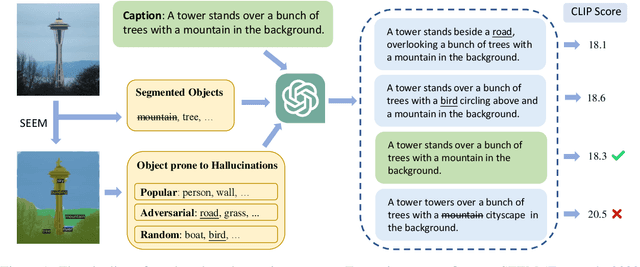
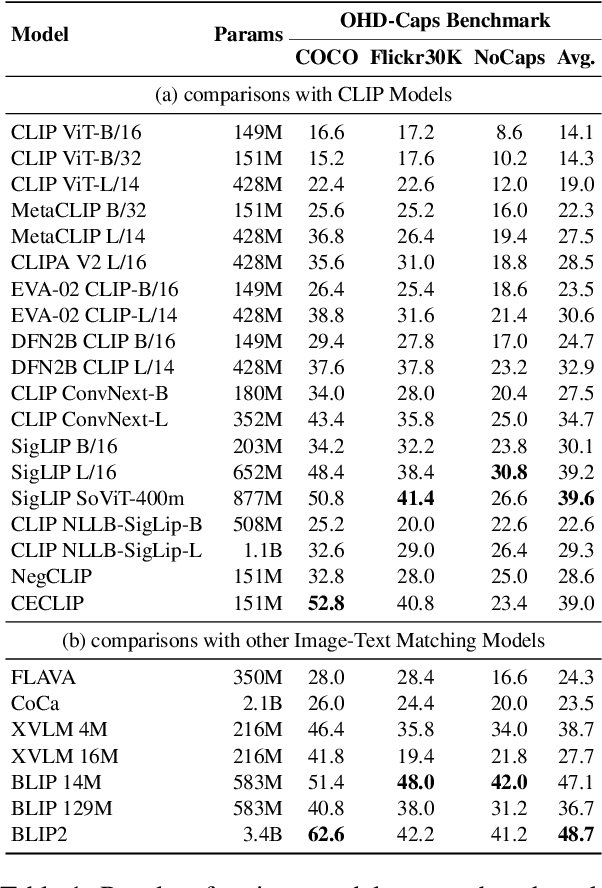
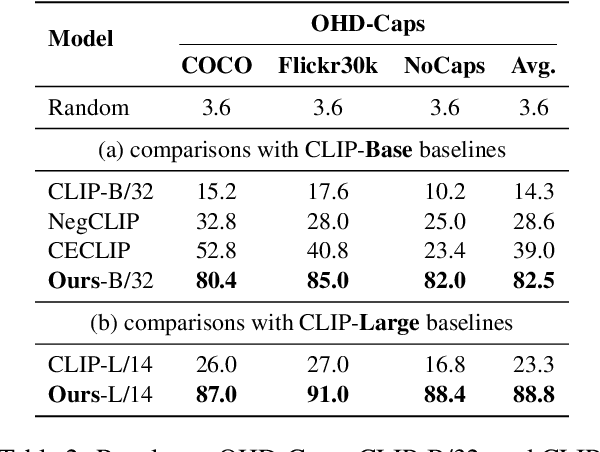
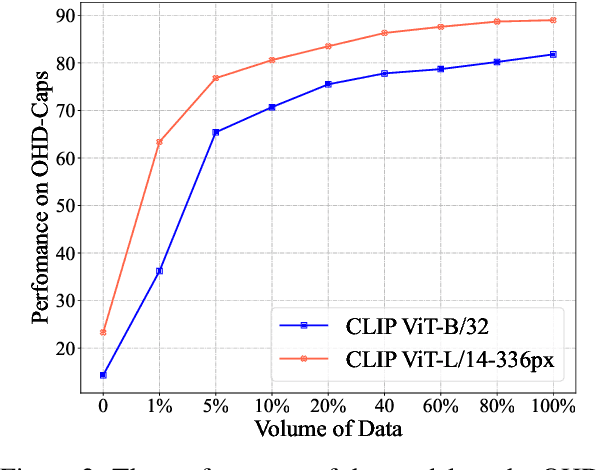
Abstract:Large Vision-Language Models (LVLMs) have achieved impressive performance, yet research has pointed out a serious issue with object hallucinations within these models. However, there is no clear conclusion as to which part of the model these hallucinations originate from. In this paper, we present an in-depth investigation into the object hallucination problem specifically within the CLIP model, which serves as the backbone for many state-of-the-art vision-language systems. We unveil that even in isolation, the CLIP model is prone to object hallucinations, suggesting that the hallucination problem is not solely due to the interaction between vision and language modalities. To address this, we propose a counterfactual data augmentation method by creating negative samples with a variety of hallucination issues. We demonstrate that our method can effectively mitigate object hallucinations for CLIP model, and we show the the enhanced model can be employed as a visual encoder, effectively alleviating the object hallucination issue in LVLMs.
CMM-Math: A Chinese Multimodal Math Dataset To Evaluate and Enhance the Mathematics Reasoning of Large Multimodal Models
Sep 04, 2024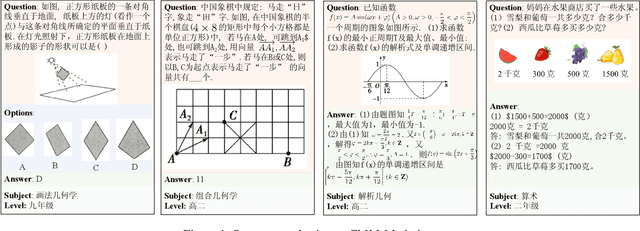
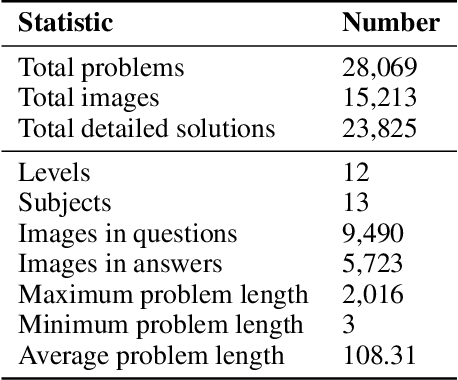
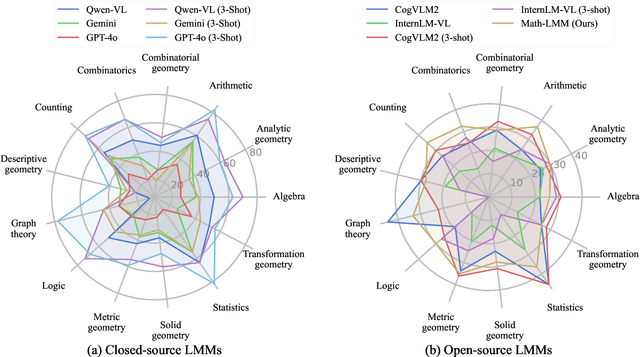
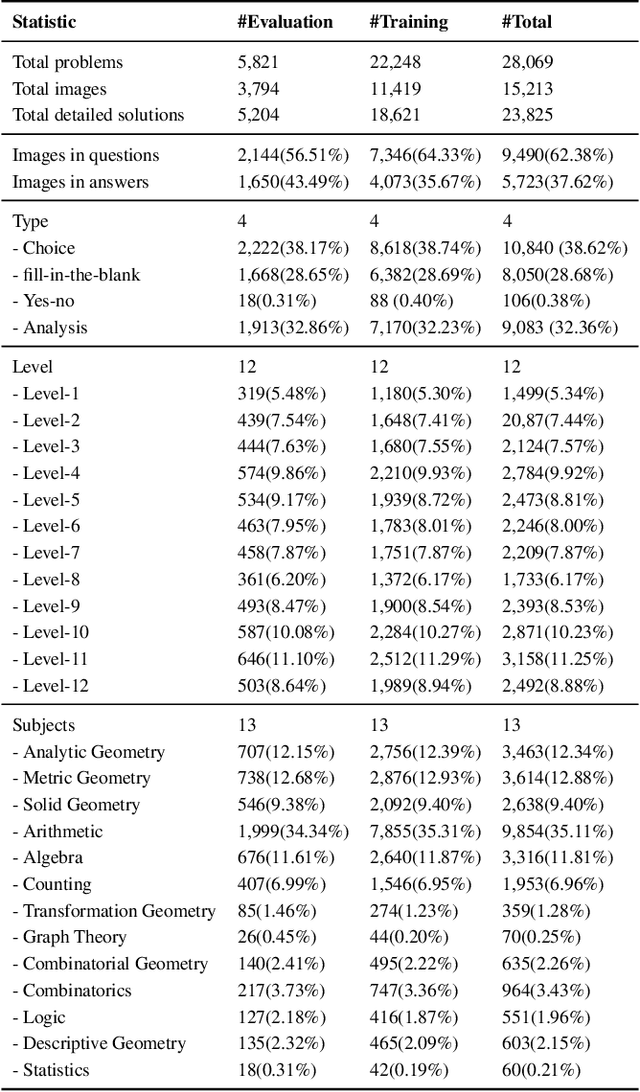
Abstract:Large language models (LLMs) have obtained promising results in mathematical reasoning, which is a foundational skill for human intelligence. Most previous studies focus on improving and measuring the performance of LLMs based on textual math reasoning datasets (e.g., MATH, GSM8K). Recently, a few researchers have released English multimodal math datasets (e.g., MATHVISTA and MATH-V) to evaluate the effectiveness of large multimodal models (LMMs). In this paper, we release a Chinese multimodal math (CMM-Math) dataset, including benchmark and training parts, to evaluate and enhance the mathematical reasoning of LMMs. CMM-Math contains over 28,000 high-quality samples, featuring a variety of problem types (e.g., multiple-choice, fill-in-the-blank, and so on) with detailed solutions across 12 grade levels from elementary to high school in China. Specifically, the visual context may be present in the questions or opinions, which makes this dataset more challenging. Through comprehensive analysis, we discover that state-of-the-art LMMs on the CMM-Math dataset face challenges, emphasizing the necessity for further improvements in LMM development. We also propose a Multimodal Mathematical LMM (Math-LMM) to handle the problems with mixed input of multiple images and text segments. We train our model using three stages, including foundational pre-training, foundational fine-tuning, and mathematical fine-tuning. The extensive experiments indicate that our model effectively improves math reasoning performance by comparing it with the SOTA LMMs over three multimodal mathematical datasets.
 Add to Chrome
Add to Chrome Add to Firefox
Add to Firefox Add to Edge
Add to Edge